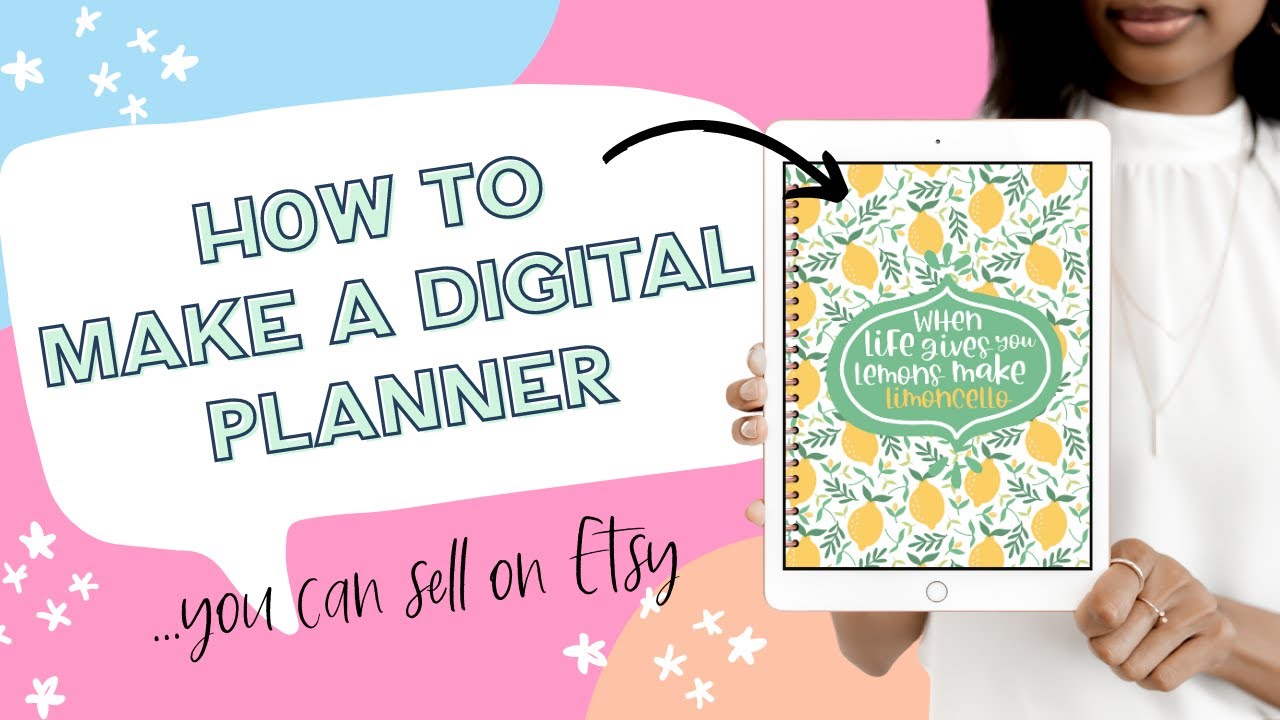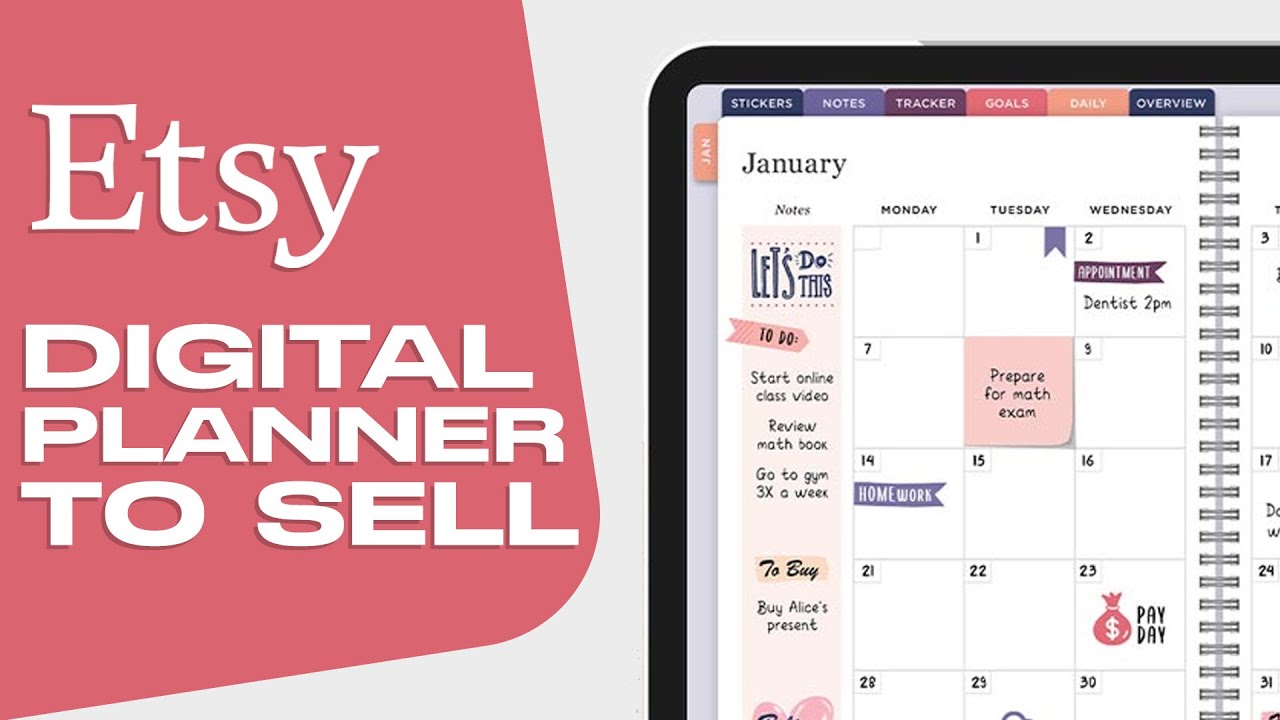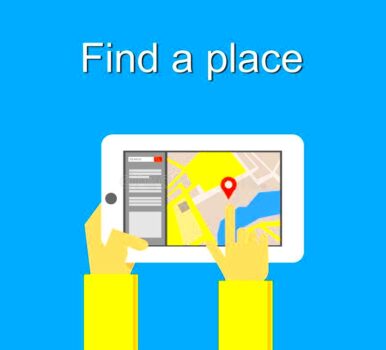Introduction
In the digital age, planners have evolved from traditional paper formats to versatile digital tools that can be used on various devices. The convenience and flexibility of digital planners make them increasingly popular, especially among those who value organization and productivity. This blog post will guide you through the process of creating, selling, and promoting digital planners on Etsy. Whether you're a graphic designer or simply someone with a knack for planning, this guide will help you turn your ideas into a profitable venture.
Also Read This: A Top List of Linkedin Graphic Designer Jobs
The Rise of Digital Planners

Digital planners have surged in popularity due to their convenience and adaptability. Unlike traditional paper planners, digital planners offer an array of features that cater to the modern user's needs. Here’s a closer look at why digital planners are becoming a favorite choice:
- Accessibility: Digital planners can be accessed from multiple devices such as tablets, smartphones, and computers. This ensures that users can keep track of their schedules and tasks wherever they are.
- Eco-Friendly: By reducing the need for paper, digital planners are a more sustainable option, helping to decrease environmental impact.
- Customization: Users can easily customize digital planners with various themes, layouts, and functionalities to suit their personal preferences and needs.
- Integration: Many digital planners integrate with other apps and tools, such as calendar applications and to-do lists, providing a seamless experience.
- Searchable Content: Unlike paper planners, digital planners allow for quick searches and easy navigation through entries, enhancing productivity and organization.
Here's a comparison table to illustrate the benefits of digital planners over traditional paper planners:
| Feature | Digital Planner | Paper Planner |
|---|---|---|
| Portability | High (accessible on multiple devices) | Limited (physical carry) |
| Customization | Easy (variety of templates and designs) | Limited (fixed layouts) |
| Search Functionality | Yes (search and filter features) | No (manual searching) |
| Environmental Impact | Low (paperless) | High (paper usage) |
The growth of digital planners is closely tied to advancements in technology and changing user preferences. As more people seek efficient and eco-friendly solutions, the demand for digital planners is likely to continue increasing. This shift presents a significant opportunity for creators and entrepreneurs to enter the market and offer valuable tools to a broad audience.
Also Read This: A Marketing Tutor’s Guide to Geotagging Images
Why Etsy is the Perfect Marketplace for Digital Planners
Etsy has established itself as a premier platform for handmade, vintage, and unique goods, making it an ideal marketplace for digital planners. Here’s why Etsy stands out as the perfect venue for selling digital planners:
- Targeted Audience: Etsy attracts a community of buyers who are specifically interested in unique and customizable items. This audience is likely to appreciate the personalized and creative aspects of digital planners.
- Easy Setup: Creating a shop on Etsy is straightforward. With user-friendly tools and templates, you can set up your store and start listing your digital planners without needing advanced technical skills.
- Cost-Effective: Etsy's listing fees and commission rates are relatively low compared to other marketplaces, making it a budget-friendly option for new sellers. You pay a small fee per listing and a percentage of each sale.
- Built-in Traffic: Etsy has a high volume of traffic, with millions of active buyers visiting the site daily. This built-in audience increases the visibility of your digital planners and helps drive potential sales.
- Customizable Listings: Etsy allows you to create detailed listings with high-quality images, descriptions, and pricing options. This flexibility helps in showcasing your digital planners effectively.
- Marketing Tools: Etsy offers various marketing tools and features, such as promoted listings and social media integration, to help boost the visibility of your products and attract more customers.
- Customer Trust: Etsy is a well-known and trusted platform. Buyers feel more secure purchasing from Etsy due to its buyer protection policies and customer service support.
To further illustrate, here’s a comparison of Etsy and other potential platforms for selling digital planners:
| Feature | Etsy | Other Marketplaces |
|---|---|---|
| Marketplace Traffic | High (millions of visitors) | Varies (depends on platform) |
| Setup Fees | Low (listing fees and commission) | Varies (often higher) |
| Customization | High (customizable listings) | Varies (some limited options) |
| Marketing Tools | Integrated (promoted listings, social media) | Varies (some may lack integrated tools) |
| Customer Trust | High (established reputation) | Varies (depends on platform) |
Overall, Etsy's combination of a dedicated audience, cost-effectiveness, and powerful marketing tools makes it a prime choice for selling digital planners. Leveraging these advantages can help you successfully launch and grow your digital planner business.
Also Read This: Using Getty Images Images on YouTube: Guidelines for Incorporating Copyrighted Content
Getting Started with Your Digital Planner Business
Embarking on a digital planner business requires careful planning and execution. From conceptualizing your product to setting up your online store, here’s a step-by-step guide to help you get started:
1. Define Your Niche
Understanding your target market is crucial. Consider the following niches within the digital planner market:
- Productivity Planners: Focus on tools that help users organize tasks and set goals.
- Academic Planners: Design planners tailored for students and educators.
- Health and Wellness Planners: Create planners that track fitness, diet, and mental well-being.
- Personal Finance Planners: Develop planners that assist users in budgeting and managing finances.
2. Design Your Digital Planner
Design is a critical element in the success of your digital planner. Follow these tips for effective design:
- Choose a Software: Use tools like Adobe Illustrator, Affinity Designer, or Canva to create your planner.
- Template Layout: Design a clean and user-friendly layout. Consider including features such as calendars, to-do lists, and goal trackers.
- Customization Options: Offer various designs and customization options to cater to different preferences.
3. Create High-Quality Content
Ensure your digital planner content is engaging and useful. Include:
- Interactive Elements: Incorporate clickable tabs, links, and checkboxes for enhanced functionality.
- Visual Appeal: Use appealing graphics, fonts, and colors that align with your brand.
- Instructions: Provide clear instructions on how to use the planner effectively.
4. Set Up Your Etsy Shop
To start selling on Etsy, follow these steps:
- Create an Etsy Account: Sign up for an Etsy account if you don’t already have one.
- Open Your Shop: Follow Etsy’s step-by-step process to set up your shop, including choosing a shop name and adding payment details.
- List Your Products: Create detailed product listings with high-quality images, thorough descriptions, and clear pricing.
5. Market Your Digital Planners
Effective marketing can significantly boost your sales. Consider these strategies:
- Social Media: Promote your digital planners on platforms like Instagram, Pinterest, and Facebook.
- Content Marketing: Start a blog or YouTube channel to share tips and showcase your planners.
- Collaborations: Partner with influencers or bloggers in the planning and productivity niche.
By following these steps, you can successfully launch and manage your digital planner business, setting the stage for growth and profitability.
Also Read This: Variation Visualization: Adding Variations to Your eBay Listings
Designing Your Digital Planner
Designing an effective digital planner involves more than just creating an attractive layout. It requires a balance between aesthetics, functionality, and usability. Here’s a comprehensive guide to designing your digital planner:
1. Choose the Right Software
To design a digital planner, you need to select the appropriate design software. Popular options include:
- Adobe Illustrator: Ideal for detailed vector designs and high-quality graphics.
- Affinity Designer: A cost-effective alternative to Adobe with powerful design tools.
- Canva: User-friendly with a wide range of templates and design elements, perfect for beginners.
2. Design Layout and Structure
Your planner’s layout should be intuitive and user-friendly. Consider these elements:
- Cover Page: Design an eye-catching cover that reflects the theme of your planner.
- Monthly/Weekly/Day Pages: Create clear, organized pages for daily, weekly, and monthly planning. Include spaces for notes, tasks, and appointments.
- Interactive Features: Add clickable tabs, hyperlinks, and checkboxes for enhanced usability.
- Customizable Sections: Offer options for users to add or remove sections according to their needs.
3. Incorporate Visual Appeal
Visual design plays a crucial role in attracting users. Focus on:
- Color Scheme: Use a cohesive color palette that is visually appealing and not overwhelming.
- Typography: Choose readable fonts and maintain consistency across your planner.
- Graphics and Icons: Include relevant icons and graphics to enhance the user experience without cluttering the page.
4. Optimize for Different Devices
Ensure that your digital planner is functional across various devices:
- Tablet Compatibility: Design with touch interfaces in mind, ensuring buttons and links are easily clickable.
- Phone Compatibility: Optimize layouts for smaller screens while maintaining usability.
- Desktop Compatibility: Ensure that your planner looks good and functions well on larger screens.
5. Test and Revise
Before finalizing your digital planner, conduct thorough testing:
- Beta Testing: Share your planner with a small group of users to gather feedback and identify issues.
- Functionality Check: Test all interactive features to ensure they work as intended.
- Revisions: Make necessary adjustments based on user feedback and testing results.
By focusing on these aspects, you can create a well-designed digital planner that is not only visually appealing but also highly functional, meeting the needs of your target audience.
Also Read This: Flipping an Image in PowerPoint: A Tutorial
Listing Your Planner on Etsy
Once you have designed your digital planner, listing it on Etsy is the next crucial step to reaching your target audience and driving sales. Here’s a detailed guide to help you create an effective and attractive Etsy listing:
1. Prepare High-Quality Images
Visual presentation is key to attracting buyers. Follow these tips for creating high-quality images:
- Clear and Detailed: Use high-resolution images that showcase different aspects of your planner, including cover designs, interior pages, and any interactive features.
- Multiple Angles: Provide images from various angles to give a comprehensive view of your planner.
- Consistent Style: Maintain a consistent style across all images to ensure a professional look.
2. Write an Engaging Title
Your title should be descriptive and include relevant keywords. Consider the following:
- Keywords: Incorporate terms that potential buyers might search for, such as "digital planner," "printable planner," and specific themes or features.
- Clarity: Clearly describe what your planner offers and its unique features in the title.
3. Create a Compelling Description
Your description should provide all necessary information about your planner. Include:
- Features: Detail the features of your planner, such as interactive elements, customization options, and layout types.
- Usage Instructions: Offer guidance on how to use the planner, including any software or apps required.
- Benefits: Highlight the benefits of using your planner, such as improved organization or productivity.
- Size and Format: Specify the file formats available (e.g., PDF, PNG) and any size options.
4. Set a Competitive Price
Pricing can impact your sales. Consider these factors:
- Market Research: Research similar planners on Etsy to gauge competitive pricing.
- Costs: Factor in any costs associated with creating and listing your planner.
- Value: Set a price that reflects the value of your planner, considering its features and quality.
5. Add Tags and Categories
Tags and categories help buyers find your planner. Use:
- Relevant Tags: Include tags related to the type of planner, target audience, and specific features (e.g., "goal planner," "student planner").
- Appropriate Categories: Choose the most relevant categories for your planner to improve its visibility.
6. Offer Excellent Customer Support
Providing excellent customer service can lead to positive reviews and repeat buyers. Ensure you:
- Respond Promptly: Answer customer inquiries quickly and professionally.
- Provide Clear Instructions: Ensure that customers know how to download and use their digital planner.
By following these steps, you can effectively list your digital planner on Etsy, making it more appealing to potential buyers and increasing your chances of success.
Also Read This: Tool to Download Shutterstock Images for Free
Marketing Your Digital Planner
Marketing is essential to stand out in the competitive digital planner market. Effective marketing strategies can drive traffic to your Etsy store and boost sales. Here’s how to market your digital planner effectively:
1. Utilize Social Media
Social media platforms are powerful tools for reaching potential customers. Consider the following:
- Instagram: Share visually appealing images and videos of your digital planner. Use stories, reels, and posts to engage with your audience.
- Pinterest: Create pins with attractive images and direct links to your Etsy shop. Pinterest is particularly effective for visual products like planners.
- Facebook: Join groups related to planning and productivity, and share your planner with the community. You can also use Facebook Ads to target specific demographics.
2. Start a Blog
Blogging can help drive organic traffic to your Etsy shop and establish you as an authority in the planning niche. Here’s what to focus on:
- Content Ideas: Write posts about productivity tips, planner organization, and how to use digital planners effectively.
- SEO Optimization: Optimize your blog posts with relevant keywords to improve search engine visibility and attract potential customers.
- Calls to Action: Include clear calls to action in your blog posts, directing readers to your Etsy store.
3. Leverage Email Marketing
Email marketing allows you to build a relationship with your audience and keep them informed about new products and promotions:
- Build a List: Collect email addresses through your website or social media channels by offering a freebie or discount.
- Send Regular Updates: Share updates about new planner designs, special offers, and planning tips with your subscribers.
- Personalize Emails: Tailor your email content based on subscriber interests and past purchases to increase engagement.
4. Collaborate with Influencers
Partnering with influencers can expand your reach and credibility:
- Identify Influencers: Look for influencers in the planning, productivity, or lifestyle niches with a following that aligns with your target audience.
- Offer Free Products: Provide influencers with free digital planners in exchange for reviews or mentions on their platforms.
- Track Results: Monitor the impact of influencer collaborations on your sales and engagement metrics.
5. Utilize Etsy’s Marketing Tools
Etsy offers several tools to help you promote your products:
- Promoted Listings: Use Etsy’s advertising options to increase the visibility of your digital planner in search results.
- Sales and Coupons: Create special offers, discounts, and coupons to attract new customers and reward loyal buyers.
By implementing these marketing strategies, you can effectively promote your digital planner, attract more customers, and increase sales on Etsy.
Also Read This: The Best TikTok Trends of 2023: How to Jump on the Bandwagon
Managing and Growing Your Digital Planner Business
Once your digital planner business is up and running, effective management and growth strategies are essential for long-term success. Here’s how you can manage and expand your business:
1. Track Performance and Analyze Data
Monitoring your business performance helps you understand what’s working and what needs improvement:
- Sales Analytics: Use tools like Etsy’s Shop Manager to track sales trends, popular products, and customer demographics.
- Customer Feedback: Regularly review customer reviews and feedback to identify areas for improvement and new opportunities.
- Traffic Sources: Analyze where your traffic is coming from (e.g., social media, search engines) to allocate marketing resources effectively.
2. Optimize Your Product Listings
Regularly updating and optimizing your product listings can enhance visibility and attract more buyers:
- Update Descriptions: Refine your product descriptions based on customer feedback and trends. Ensure they are clear, engaging, and keyword-rich.
- Refresh Images: Periodically update your product images to keep them current and visually appealing.
- SEO Practices: Continuously optimize your listings for Etsy’s search engine by using relevant keywords and tags.
3. Expand Your Product Line
Diversifying your product offerings can attract new customers and increase sales:
- New Designs: Regularly introduce new planner designs and features to keep your offerings fresh and appealing.
- Related Products: Consider adding complementary products, such as planner accessories, printable stickers, or goal-setting worksheets.
- Customer Requests: Pay attention to customer requests and suggestions to create products that meet their needs.
4. Foster Customer Relationships
Building strong relationships with your customers can lead to repeat business and positive word-of-mouth:
- Engage on Social Media: Interact with your customers through social media by responding to comments, hosting giveaways, and sharing user-generated content.
- Provide Excellent Customer Service: Offer prompt and helpful support to address any issues or questions your customers may have.
- Send Newsletters: Keep customers informed about new products, promotions, and special offers through regular newsletters.
5. Invest in Marketing and Advertising
Ongoing marketing and advertising efforts are crucial for sustained growth:
- Paid Advertising: Invest in targeted ads on platforms like Etsy, Google, or social media to reach a larger audience.
- Collaborations: Partner with influencers and bloggers to expand your reach and gain credibility in your niche.
- Seasonal Promotions: Plan seasonal promotions and sales events to attract new customers and boost sales.
By implementing these strategies, you can effectively manage and grow your digital planner business, ensuring its continued success and expansion.
Also Read This: How to Find a Place from an Image
FAQs
Here are some frequently asked questions about starting and managing a digital planner business on Etsy:
1. What software should I use to design a digital planner?
Popular software options include Adobe Illustrator, Affinity Designer, and Canva. Adobe Illustrator and Affinity Designer are great for detailed vector designs, while Canva is more user-friendly and ideal for beginners.
2. How much should I charge for my digital planner?
Pricing can vary based on factors such as the complexity of the planner, market trends, and competition. Conduct research on similar products on Etsy to determine a competitive price. Consider the value your planner offers and any associated costs.
3. How can I improve the visibility of my digital planner on Etsy?
To improve visibility, optimize your product listings with relevant keywords, use high-quality images, and engage in Etsy’s marketing tools like promoted listings. Additionally, leveraging social media and content marketing can drive traffic to your Etsy store.
4. What are some effective marketing strategies for digital planners?
Effective marketing strategies include utilizing social media platforms (such as Instagram, Pinterest, and Facebook), starting a blog, leveraging email marketing, collaborating with influencers, and using Etsy’s marketing tools. Each strategy helps increase your planner’s exposure and attract potential buyers.
5. How do I handle customer feedback and reviews?
Regularly review customer feedback and address any issues promptly. Positive feedback can be used to enhance your listings, while negative feedback should be taken constructively to improve your product and service. Engaging with customers professionally and resolving any issues can help build trust and loyalty.
6. Can I sell my digital planner on platforms other than Etsy?
Yes, you can sell digital planners on other platforms such as your own website, other online marketplaces like Gumroad or Creative Market, or through social media channels. Diversifying your sales channels can help reach a broader audience and increase sales.
7. How often should I update my digital planner offerings?
Regular updates are essential to keep your products relevant and appealing. Consider introducing new designs and features periodically, based on customer feedback and market trends. Seasonal updates or special editions can also attract new customers and retain existing ones.
Conclusion
Starting and growing a digital planner business can be a rewarding venture with the right approach. By carefully designing your digital planners, effectively listing them on Etsy, and implementing robust marketing strategies, you can successfully reach your target audience and achieve business growth.
Begin by defining your niche and designing planners that cater to the specific needs of your audience. Ensure your Etsy listings are compelling, with high-quality images and detailed descriptions that highlight the unique features of your planners. Utilize various marketing channels, such as social media, blogging, and email marketing, to increase visibility and attract potential buyers.
As you manage and grow your business, regularly track performance metrics, optimize your product listings, and expand your product line to keep your offerings fresh and relevant. Building strong customer relationships and investing in ongoing marketing efforts will further support the success of your digital planner business.
With a strategic approach and continuous improvement, you can create a thriving digital planner business that stands out in the marketplace and meets the needs of your customers. Embrace the journey and stay adaptable to the evolving trends and demands of the digital planning world.

 admin
admin









